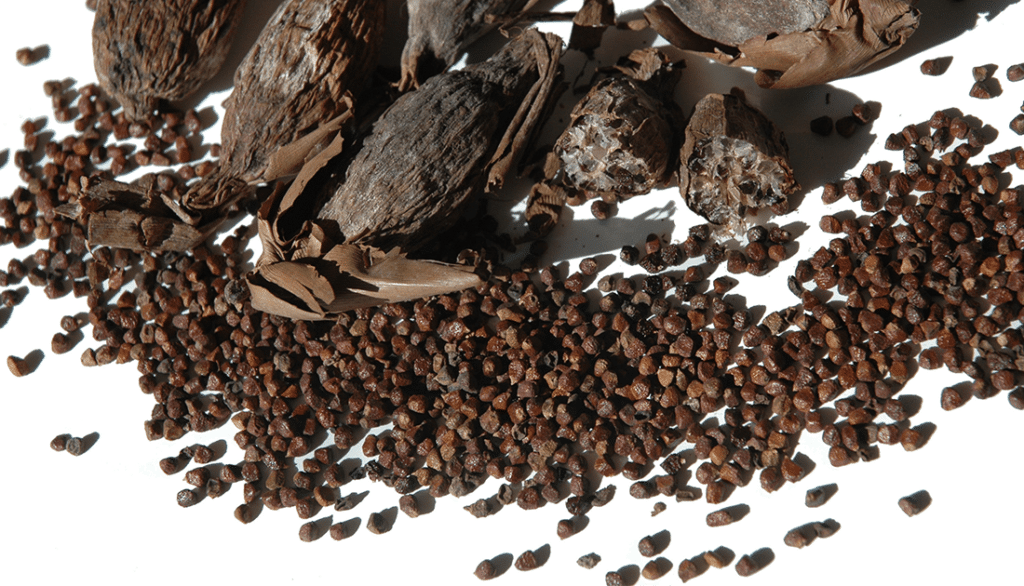Burning fat and losing unwanted weight usually involves two things -- lots of exercising or eating an insanely restrictive, low-calorie diet. Neither of these sounds appealing to most people, which is part of the reason so many people struggle to lose weight in the first place.
There’s always the option of trying out a fat burner or two, but you run the risk of either wasting your money on a completely useless product, or having it make you feel anxious, jittery, and on edge due to the cocktail of stimulants commonly found in OTC weight loss supplements.
Wouldn’t it be great if you could burn some extra fat without having to take a bunch of potentially hazardous stimulants or spend hours and hours on the treadmill?!
Your prayers might have been answered with Paradoxine®, a patented, standardized extract of Grains of Paradise that provides body re-composition benefits, without impacting your cardiovascular system.
What is Grains of Paradise?
Native to West Africa, Grains of Paradise (Aframomum melegueta) is a spice belonging to the Zingiberaceae family of plants that are similar to ginger. The pods of the plant contain reddish-brown seeds that are ground to give the spicy, peppery spice commonly used in cooking today. Grains of Paradise can be found other several other names, including:- Melegueta Pepper
- Fom Wisa
- Alligator Pepper
- Guinea Grains
- Ossame
- 6-paradol
- 6-gingerdione
- 6-gingerol
- 6-shogaol
How Does Paradoxine® Work in the Body?
To understand how Paradoxine works in the body requires a discussion of the different types of adipose tissue (a.k.a. fat) in your body. There are two types of fat in the body:- Brown Adipose Tissue (BAT)
- White Adipose Tissue (WAT)
White Fat
Your body’s energy storage cells. Whatever extra calories aren’t immediately needed by the body are stored as “white” fat and are used when food intake is reduced. <1> White fat cells are large, round cells comprised of one big lipid droplet with a thin rim containing the nucleus and cytoplasm.Brown Fat
On the other hand, is the fat used for diet and cold-induced thermogenesis, maintaining your body’s normal temperature when exposed to cold. <1> The technical term for this is “non-shivering thermogenesis.” Brown fat cells aren’t only different in function than white fat cells, they’re structure is also different. Brown fat cells are comprised of smaller diameter cells, containing several smaller fat droplets compared to the one massive droplet that’s found in white fat. The magic of Paradoxine® lies in its ability to brown your fat. That is, it transforms your white fat cells into brown fat cells, increasing energy expenditure and boosting weight loss. An added benefit to brown fat is that it can use blood sugar (glucose) and fats, leading to improved lipid levels and glucose metabolism, independent of weight loss! <8>Paradoxine® Benefits
There have been quite a few purported stimulant-free fat burning supplements over the years, but when you dig down into the research, you see that they’re not actually all they’re cracked up to be. That’s not the case with Paradoxine®. It actually has human trials demonstrating its effectiveness.Increased Energy Expenditure
A 2013 study involving 19 healthy men, age 20-32, gave them either placebo or 40mg per day of Grains of Paradise extract. During the course of the four-week trial, researchers then placed the men in an air-conditioned room at 19°C (66.2°F) for two hours only wearing “light clothing” (a T-shirt with underwear). As if that wasn’t enough, they also had the men place their feet onto an ice block wrapped in cloth on and off (4 minutes on, 5 minutes off). Following this two-hour cold fest, subjects underwent testing which included having their whole-body energy expenditure measured following a 6-12 hour fasting period. Researchers observed that the men consuming Grains of Paradise extract had a significantly greater increase in energy expenditure, seemingly due to the increased brown fat activity, than the group not receiving placebo. <2>Increased Fat Loss
The other notable human trial on Paradoxine® involved women and measuredthe effects of the extracts on energy expenditure as well as body fat. 19 non-obese women (ages 20-22) were divided into two groups. The treatment group received one 10mg capsule of Grains of Paradise extract 30 minutes prior to each of their three daily meals, for a total of 30mg Grains of Paradise Extract per day. While the other group received a placebo. At the end of the four-week trial, women again had their body fat and energy expenditure measured, and again the group receiving the Grains of Paradise extract has significantly greater results. Women receiving the extract experienced reduced visceral fat in the lower abdomen and greater energy expenditure while the placebo group saw a modest increase in visceral fat in the same area. <3> The important thing to note here is that these results were obtained without any extra diet or exercise modifications!Additional Benefits
Several animal studies have also been carried out using Grains of Paradise extracts and noted it lowered blood pressure, improved lipid profiles, and reduced chemical-induced liver damage (hepatotoxicity). <6,7>Why Paradoxine®?
You’re probably wondering why we’re suggesting you use Paradoxine® as the preferred choice for a Grains of Paradise extract. The reason, is that it’s the only Grains of Paradise extract backed by any actual human research. It’s standardized to 15% Aframols® & 12.5% 6-paradol, the same grade of extract used in the human trials, and it’s backed by high-performance liquid chromatography (HPLC) tests.Who is Paradoxine® for?
Paradoxine® is ideal for anyone looking for improved body composition and enhanced fat loss from their supplements. It’s perfect to use in a thermogenic pre-workout, or as part of a more comprehensive fat burning formula. Paradoxine® is especially ideal for those stim-sensitive individuals who still want to get some extra fat burning, but don’t want the stims contained in most fat burners on the market.Paradoxine® Dosage
Typically, Paradoxine® is dosed anywhere from 25-50mg per day, and with the “sweet spot” being in the 40-50mg range. This is where you’ll start to notice the enhanced thermogenic effect of the supplements, in the form of feeling significantly warmer than usual. And expect to be sweating buckets during your workout if your pre-workout contains a sizeable dose of this potent thermogenic. SteelFit® uses 40mg/serving of Paradoxine® in its stimulant free fat burner Steel Core® and 50mg/serving in its cardio enhancing pre-workout Steel Sweat™.References
- Rosenwald M, Wolfrum C; “The origin and definition of brite versus white and classical brown adipocytes”; Adipocyte; 2014;3(1):4-9; https://www.ncbi.nlm.nih.gov/pmc/articles/PMC3917931/
- Sugita, J., Yoneshiro, T., et al; “Grains of paradise (Aframomum melegueta) extract activates brown adipose tissue and increases whole-body energy expenditure in men”; British Journal of Nutrition; (2013) 110(4), pp. 733–738; https://www.cambridge.org/core/journals/british-journal-of-nutrition/article/grains-of-paradise-aframomum-melegueta-extract-activates-brown-adipose-tissue-and-increases-whole-body-energy-expenditure-in-men/517F8F0D73864C919E42D502537BA01D/core-reader
- Sugita J, Yoneshiro T, et al; “Daily ingestion of grains of paradise (Aframomum melegueta) extract increases whole-body energy expenditure and decreases visceral fat in humans”; Journal of Nutritional Science and Vitaminology; 2014, 60(1): 22-27; https://www.jstage.jst.go.jp/article/jnsv/60/1/60_22/_pdf
- Momoe Iwami, Fatma A. Mahmoud, et al; “Extract of grains of paradise and its active principle 6-paradol trigger thermogenesis of brown adipose tissue in rats”; Autonomic Neuroscience: Basic and Clinical; 161 (2011); 63–67; https://www.docdroid.net/Iog80CU/momoe-iwami-paradise-study.pdf.html
- Ilic N, Schmidt BM, Poulev A, Raskin I; “Toxicological evaluation of Grains of Paradise (Aframomum melegueta)
K. Schum”; Journal of ethnopharmacology. 2010;127(2); https://www.ncbi.nlm.nih.gov/pmc/articles/PMC3815460/ - Adefegha, Stephen A. et al; “Alligator pepper/Grain of Paradise (Aframomum melegueta) modulates Angiotensin-I converting enzyme activity, lipid profile and oxidative imbalances in a rat model of hypercholesterolemia”; Pathophysiology; Volume 23, Issue 3, 191 – 202; http://www.pathophysiologyjournal.com/article/S0928-4680(16)30026-8/fulltext
- Semwal R, Semwal D, Combrinck S, Viljoen A; “Gingerols and shogaols: Important nutraceutical principles from ginger”; Phytochemistry; https://www.docdroid.net/TZ53eaP/gingerols-and-shogaols-important-nutraceutical-principles-from-ginger.pdf.html
- Kim SH, Plutzky J; “Brown Fat and Browning for the Treatment of Obesity and Related Metabolic Disorders”; Diabetes & Metabolism Journal. 2016;40(1):12-21; https://www.ncbi.nlm.nih.gov/pmc/articles/PMC4768046/
- U.S. Department of Health and Human Services; Food and Drug Administration; “Guidance for Industry: Estimating the Maximum Safe Starting Dose in Initial Clinical Trials for Therapeutics in Adult Healthy Volunteers”; July 2005; http://www.fda.gov/downloads/Drugs/GuidanceComplianceRegulatoryInformation/Guidances/ucm078932.pdf
- Wikipedia contributors; “List of Good Eats episodes.”; Wikipedia, The Free Encyclopedia; July 21 2016; https://en.wikipedia.org/wiki/List_of_Good_Eats_episodes#cite_note-33
- Saito, A; “Acute oral toxicity of capsaicin in mice and rats.”; The Journal of Toxicological Sciences; 1996 Aug; 21(3):195-200; https://www.ncbi.nlm.nih.gov/pubmed/8887888

